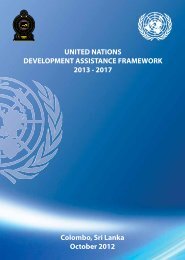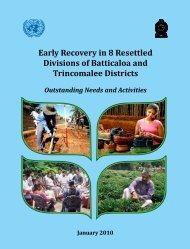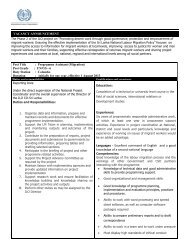Sri Lanka Human Development Report 2012.pdf
Sri Lanka Human Development Report 2012.pdf
Sri Lanka Human Development Report 2012.pdf
You also want an ePaper? Increase the reach of your titles
YUMPU automatically turns print PDFs into web optimized ePapers that Google loves.
offered by private institutions. 189 Given the consensus that<br />
the higher education sector needs to be revamped, the<br />
implementation of reforms in a transparent and systematic<br />
manner can minimize resistance to change.<br />
The reforms extend to technical education and vocational<br />
training, which is available throughout the country, but<br />
with skewed distribution (Figure 4.11), as is apparent by<br />
public sector enrolment across provinces. Availability is<br />
highest in the Western Province, where around 34,000<br />
examinations. In 2010, 146,500 school candidates did<br />
not pass the O-Level exam, while another 76,000 did not<br />
succeed at the A-Level. 190 The majority of these young<br />
people are not equipped with marketable skills, which<br />
is one reason why youth unemployment is so high: 19.4<br />
percent for 15 to 24 year olds in 2010, compared to a<br />
national average of only 4.9 percent. 191 Training is critical<br />
to facilitating the transition from school to work and to<br />
reducing unemployment. 192 70 percent of those who are<br />
unemployed did not have any vocational training. 193<br />
Figure 4.11: Technical and Vocational Training: Enrolment in Selected Public<br />
sector Institutions, 2010<br />
Source: Tertiary and Vocational Education Commission 2010a.<br />
young people were enrolled in 2010. It is lowest in Uva,<br />
where enrolment was below 4,000 people. Enrolment was<br />
below 5,000 students in the North Central, North Western<br />
and Sabaragamuwa provinces. In the Western, Central,<br />
Eastern and Sabaragamuwa provinces, the enrolment<br />
of men outnumbered that of women; distribution is,<br />
however, more even in the other provinces.<br />
Each year, about 200,000-250,000 young people leave<br />
the school system without succeeding in the national<br />
While young people are the prime target for technical<br />
and vocational training and skills development, these<br />
programmes are poorly recognized. Reasons include weak<br />
links between them and secondary education, 194 a lack of<br />
interaction with industry, the poor quality of training and<br />
the lack of a career development path for participants. 195<br />
In 2005, a major reform was the establishment of the<br />
National Vocational Qualification system to set standards<br />
for diploma and certificate courses. 196 Funded by the Asian<br />
<strong>Development</strong> Bank, it has mainly focused on diploma-level<br />
78<br />
sri lanka <strong>Human</strong> <strong>Development</strong> report 2012






